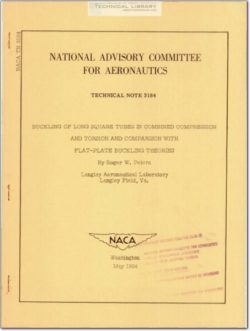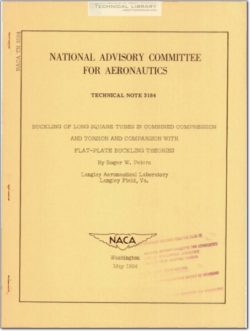NACA-TN-3184

- Version
- 505 Downloads
- 5.82 MB File Size
- 1 File Count
- April 19, 2016 Create Date
- April 19, 2016 Last Updated
National Advisory Committee for Aeronautics, Technical Notes - Buckling of Long Square Tubes in Combined Compression and Torsion and Comparison with Flat-Plate Buckling Theories

The results of buckling tests of long square tubes loaded in com—
pression, torsion, and combined compression and torsion are compared with
theoretical compression and shear buckling curves and with theoretical
interaction curves for the buckling of simply supported flat plates. A
compression buckling curve previously compared with experiment is again
shOWn to be in good agreement with experimental results; the shear
buckling curve derived from compressive stress-strain data by the secant
modulus method is in good agreement with experimental results; and theo-
retical interaction curves previously presented are in good agreement
with the results of the combined—load buckling tests. The direction of
the loading path is shown to have little or no effect on the shape of
the interaction curve.
Extensive theoretical and experimental research has been conducted
in order to evaluate the elastic and plastic buckling stresses of flat-
plate elements loaded in pure compression (see refs. 1 to 7). The problem
of the elastic and plastic buckling of flat—plate elements loaded in pure
shear has been treated theoretically and limited experimental data are
available to validate these theoretical predictions (see refs. 7 to 10).
The problem of the elastic and plastic buckling of flat—plate elements
loaded in combined shear and compression also has been treated theoret—
ically (see refs. ll to 15), but experimental comparison is available
for the elastic case only (see ref. 1h).
The purpose of this paper is to compare the predictions of the
theories for the buckling of long flat plates with the results of elastic
and plastic buckling tests on long square tubes loaded in pure compres-
sion, pure torsion, and combined compression and torsion.
Test specimens. The buckling specimens were cut from ten different
sections of drawn square tube of th—T6 aluminum alloy having a nominal
wall thickness of O.l56 inch. A sketch of the cross section and a table
of the dimensions of the tubes are presented in figure 1. The nominal
thickness of the square tubes used in this investigation is continuous
around the corners of the tube, whereas those used in reference 2 had a
smaller outside corner radius which added material at the corners of
the tube.
| File | Action |
|---|---|
| NACA-TN-3184 Buckling of Long Square Tubes in Combined Compression and Torsion and Comparison with Flat-Plate Buckling Theories.pdf | Download |

Comment On This Post